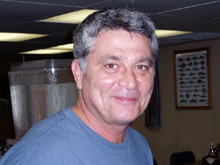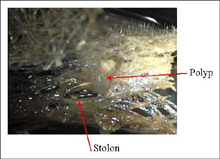
A microscopic view of a polyp from the octocoral, Anthelia sp., shown on a glass sponge. The polyp is connected to other polyps in the colony by ribbons of tissue called stolons. The ribbons of tissue contain canals that directly connect all of the polyps’ stomachs. Click image for larger view.
Seamount Serendipity
July 14, 2003
Dr. Scott France
College of Charleston, SC
Pat Frisketti
Hamden High School, CT
Diana Payne
Connecticut Sea Grant
When you do dance, I wish you
A wave o’ the sea, that you might ever do
Nothing but that.
- William Shakespeare, The Winter’s Tale, Act IV, Scene 4
![]() Dive down to Manning seamount's coral "garden." (mp4, 2.2 MB)
Dive down to Manning seamount's coral "garden." (mp4, 2.2 MB)
The Manning seamounts, located at 38 degrees N latitude, 60 W longitude, are some of the youngest in the New England seamount chain. Manning is actually a set of five closely clustered seamounts. We have been diving on the largest of the five, the shape of which resembles a chicken. The minimum depth to reach the shallowest seamount summit is 1,504 meters; the dive yesterday was to approximately 1,732 m. The actual height of the tallest Manning seamount as it rises from the abyssal plain is approximately 3,519 m.
Samples from yesterday’s Alvin dive and rock dredge were preserved and analyzed into the wee hours of the morning. Dr. Scott France was particularly excited to find what he thought might be evidence of recent coral reproduction and larval settlement. Two solitary coral polyps were on a fragment of a glass sponge that was collected using Alvin’s slurp gun.
It was thought that these polyps may have developed from coral larvae that have recently settled. Coral larvae swim for some period of time, settle, and then metamorphose into a polyp. This polyp will later undergo asexual reproduction (“cloning”)—budding off new polyps to form a colony. Among the research topics being addressed here are how many larvae corals produce, how often they reproduce, and how far these larvae can travel.
Upon closer and more critical examination of the polyps, Dr. France discovered that the polyps were not recent recruits, but rather part of a coral colony that grows like a ribbon. These types of corals, called stoloniferous, grow like strawberry plants, with a ribbon of tissue creeping along the bottom occasionally budding a polyp. The ribbon-like stolon is clearly visible in the photograph leading to the polyp. There was some disappointment that recent recruits had not been found, but we were excited that a new species of coral had been collected on the seamounts. This is the first stoloniferous coral we have collected!
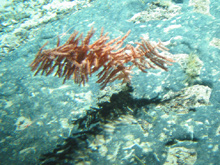
A type of black coral, Bathypathes sp. is seen from the Alvin on the Manning seamount surrounded by brittle stars and crinoids. The collecting box that the Alvin uses is visible in the picture. Click image for larger view.
Mountains in the Sea dives have been planned with the help of dive summaries and multibeam maps provided by Dr. Jess Adkins and his team from the Dive and Discover cruise in May-June 2003. Today’s Alvin dive, number 3902, brought observers Peter Auster and Jon Moore and Alvin pilot Anthony Tarantino to the south-central edifice of the “chicken.” Collaborator Lauren Mullineaux of Woods Hole Oceanographic Institution had requested that some follow-up work occur on our return to Manning. Dr. Mullineaux’s research group prepared about 40 granite blocks, each about 10 x 10 in size, with rope handles. Some of these blocks will be deployed near a “forest” of corals, while others will be deployed in areas where corals are absent. We plan to recover the blocks next year to see how many coral larvae (or larvae of other deep-sea species) have settled. This will help us understand coral recruitment (or colonization) rates and whether seamount environments experiencing different currents have different larval settling rates. Do all species produce larvae at the same rate? Will we find equal numbers of larvae from all species, or will one or more species be dominant? Does the colonization rate depend on how close the blocks are to existing coral colonies? As the data from research cruises are analyzed, we often develop more questions than answers. This is the nature of science and exploration.
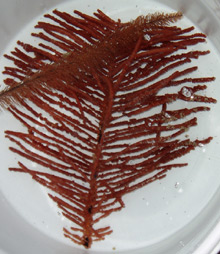
This bucket contains a sample of Bathypathes sp. black coral (larger branched specimen) and a sample of a Tanacetipathes, or bottle brush black coral (smaller brush-shaped specimen). Click image for larger view.
Today’s dive was quite successful in terms of observing fish diversity. Dr. Auster and Dr. Moore videotaped and quantified several varieties of deep-water fish. At this point, an analysis of the abundance of certain species and in which habitats they are found will be generated. The researchers were also able to assess the overall biodiversity of this site for further taxonomic referencing and compilation. This type of on-site data gathering, made possible by diving in Alvin, is unique. A much more complete and visually accurate image of this environment is attained, and the clarity and scope of the visual field for both the larger animals, such as fish, as well as the smaller invertebrates, is incredible. Dr. Moore stated, “My only other wish would be that I could get out there and fill my pockets.”
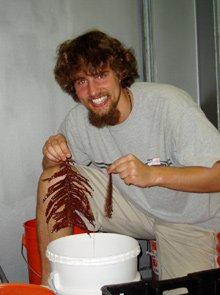
Mercer Brugler holds up a black coral specimen, which he is studying to determine any differentiations between them and tube anemones. Click image for larger view.
Interview with Mercer Brugler
Graduate Student with Dr. Scott FranceCollege of Charleston
Ocean Explorer: How did you get involved with the Mountains in the Sea Expedition?
Mercer Brugler: Dr. France has been allowing me to participate on this and other expeditions. I had also been on the previous Atlantis cruise with Dr. Jess Adkins, doing similar sampling. When I asked Dr. France why he was giving me these opportunities, his response was that people like me were the next wave of deep sea biologists and that he wanted to impart to me the experience necessary to continue this kind of work.
Ocean Explorer: What is the nature of the investigation you are involved in and what specific objectives do you hope to achieve?
Mercer Brugler: I am looking at the relationship between black corals and tube anemones by sequencing their mitochondrial genome and looking at gene order. Currently these two organisms are grouped together in the same sub-class (within the Anthozoa), although they are morphologically quite different. The reason for this is the lack of characters to show their differentiation. I am hoping to be able to show enough difference in their respective genomes to suggest revision of the present taxonomic listing.
Ocean Explorer: You will be conducting your analysis on the specimen’s mitochondrial DNA. How do you isolate this for study?
Mercer Brugler: The process is fairly standard. We digest or break down the tissue; due to the sheer volume of mitochondria compared to nuclear DNA, the ratio is in our favor. The majority of DNA will be from the mitochondria. We also begin our work using universal primers designed to amplify mitochondrial DNA. To check this we run the sequence through the GenBank – BLAST program, a web storehouse of genome information. This will compare our sequence with many others to assure we are indeed working with the mitochondrial DNA.
Ocean Explorer : Have you been able to identify any substantial differences so far?
Mercer Brugler: I recently finished sequencing the black coral genome and found some very interesting results. The tube anemone is presenting me with some problems, which may suggest that some odd secondary structure may be occurring in the mitochondrial genome. I've spent the past month or so trying to figure out some of the particulars of the genome as it pertains to its shape and length.
Ocean Explorer: You will be going on an Alvin dive later in the cruise. What are your feelings about that?
Mercer Brugler: True excitement, this is what we are really out here for. I have been down in Alvin once before, to the hydrothermal vents in the Gulf of California, and that was amazing. But the animals that I am studying are here at this site, and there are things on these seamounts that no one has ever seen before. When Alvin comes up on deck, I could be the first person to ever set eyes on these creatures.
Interview by Pasquale Frisketti of the Ocean Explorer Team.
Interview with George Silva
Captain/Master – R/V Atlantis
Woods Hole Oceanographic Institute (WHOI)
Ocean Explorer: Can you describe how you came to be involved with The Woods Hole Oceanographic Institute (WHOI) and the R/V Atlantis?
George Silva: I have been at WHOI since 1995 and worked mostly on the R/V Knorr for the first three years. Over the past five years I have spent the majority of my time on the Atlantis either as Chief Mate or Captain, although for the past several years, I have worked predominantly as Captain.
There are several directions you can take to move up the ranks, one being what is called the “hawsepipe” route. You start out as an ordinary seaman (OS). After putting in sea time and taking a test, you can move up to able-bodied seaman (AB). You can continue up the chain through progressive steps, putting in your time and taking the appropriate tests to certify for each of the levels —3rd, 2nd, 1st mate, and then to captain. You can also take the academic route through a number of organizations or the Maritime Academies. That is what I did. I am a graduate of the Massachusetts Maritime Academy.
Ocean Explorer: Working onboard a research vessel must be quite interesting and different from other types of vessels.
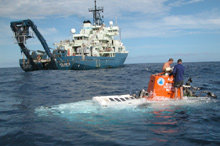
Swimmers Mark Spear and Carl Wood, recovering Alvin after dive #3902 on Manning Seamount. Photo by C. Martinez. Click image for larger view.
George Silva: All ships are different and you have different issues to deal with, but being onboard a vessel with a purpose that could have a positive impact on the world’s oceans can be very rewarding. The scientific communities we work with have specific requirements that will enable them to fulfill their objectives. We have the facilities to provide for those needs, such as specialized labs, computer resources and some of the most highly advanced technology in the world including, of course, Alvin.
What I find particularly gratifying are the people I work with and the places we visit. I am involved in working with literally hundreds of different people, including some of the most prominent scientific researchers in the world and the most talented graduate students imaginable. This can be a very humbling and rewarding experience. The interest level never drops, and there is always something new happening. The places we visit are what most people only hear about, including the Galapagos and Easter Island; we also visit some of the most interesting oceanic locations on the planet.
Of course, the main attraction is Alvin, being able to actually visit and explore the ocean floor - that is what the researchers want. Alvin also provides us with a unique opportunity to work with people responsible for disseminating the information, through public relations, the media and with groups like NOAA Ocean Exploration.
Ocean Explorer: Alvin is a very special technological research tool. From a logistical perspective, what are your concerns when Alvin is in the water?
George Silva: The most critical times are deployment and recovery. The bridge is involved with both of these, and we keep in direct communication with the Alvin Surface Controller Station or Top Lab. There are people around heavy equipment, some over the side in the chase boat, and divers in the water. You need a lot of focus and attention to keep these operations safe, efficient and productive. We have a very methodical, time-proven procedure that doesn’t change. The crew is very engaged and safety is a primary concern. They are the reason these procedures are so successful, and I’m just a small cog in this operation. I am extremely fortunate to be working with such a highly qualified and dedicated group of people.
When we are involved in these dives, weather is always a factor. Conditions can change quickly out there. It could be like glass when we launch, but eight hours later during recovery, it could be quite different. An increase of 20 knots is routine, but if it begins to blow 30 to 40 knots, it can get pretty rough, and that’s what you have to be prepared for.
Ocean Explorer: What do you see as the future for oceanographic research?
George Silva: Because we are non-commercial, funding is always a major issue. Our primary funding sources are National Science Foundation grants and donations, and these funds change from year to year. There is much discussion concerned with long-term monitoring projects, and the development and deployment of more robotic, autonomous devises. The debate will continue over the use of unmanned remotely operated vehicles versus manned submersibles. There are benefits and drawbacks to both.
Ocean Explorer: What do you enjoy most about being out here?
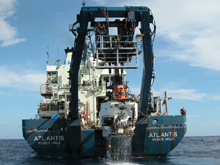
Alvin being pulled out of the water during a recovery on Manning Seamount. Photo by C. Martinez. Click image for larger view.
George Silva: This job provides an opportunity to be outside in the elements. My hobby is fishing, and I like to fish for the same reasons - to be a part of nature. Out here there is no morning commute. It is not the same thing everyday. There is constant change - always something new. You have to be at ease with your surroundings, but out here you also have to be able to react appropriately in emergencies. Of course, there is another side to the enjoyment of being out here. Many of the crew, myself included, have families, and we are at sea eight months out of the year. We miss a lot of what goes on at home. I don’t miss cutting the grass or general household chores, but some of those are always there when we return.
Interview by Pasquale Frisketti of the Ocean Explorer Team.




















